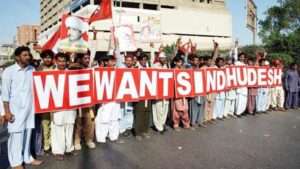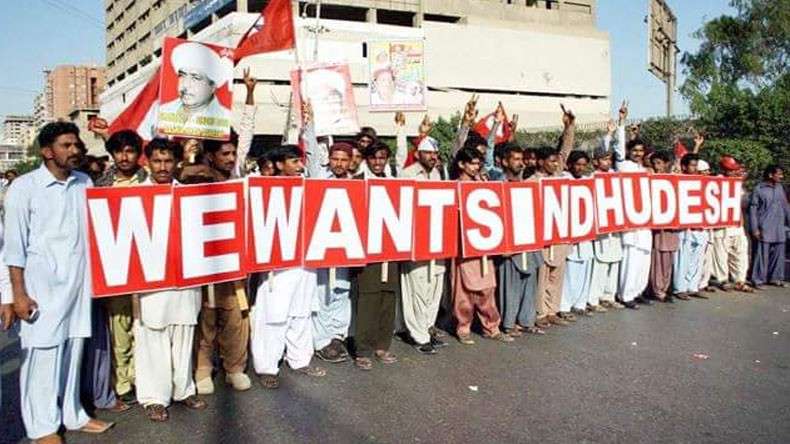Pakistan’s downfall is no longer theoretical; it is happening right now, during the conflict with India. There were many internal distressing threats to the current administration of Pakistan, and the Pakistani Army was losing its dominance over its territory day by day. On the west of the state, Baloch nationalists seek to declare freedom from the state. In the North, Pashtuns, the second largest ethnic majority of the Pakistani population, demanded their status quo for their people. The region of Pakistan’s Punjab is losing strength because, up until this region looked after the authority of other provinces, the administration has failed and systematically discriminated against other parts of the state, which has put this region under pressure and disheartened the people of Pakistan. With no surprise, the Sindh province joined the club to demand a separate state for its population.
The call for a separate nation for Sindh was put forth by the then Minister of Education of Sindh province and Sindh Nationalist Ghulam Murtaza Syed, the founding father of the Sindhudesh ideology. He was a prominent leader of South Asia during pre- and post-colonial rule. Before and after the partition, he advocated for autonomy for the Sindh province against the suppression of the British then and the New Pakistan. He was jailed for 30 years by the Pakistani authorities. He died in 1995 at the Sann home, Sindh. But his ideas are significant and motivating Sindhi nationalists against the administrative distress of the Pakistan government and army; currently, the Jeay Sindh Freedom Movement (JSFM) is carrying the Sindhudesh forward.
The main agenda of Syed’s autonomy is to secure the values, culture, and self-determination of the Sindhi people. Sindh is the third largest by area, second largest by population and owns the financial capital of Pakistan, Karachi. And it is known for its abandoned natural resources and strategic presence. However, Sindh province and its population were suppressed with no equivalent distribution and limited political representation. On the other hand Punjab region population are enjoying the wealth, but the par 60% of the national income is contributed by Sindh. Specifically, the province’s GDP (PPP) is estimated at $345 billion, with a per capita GDP of $7,209. Sindh’s revenue collection through the Sindh Revenue Board (SRB) has also shown growth, with a 27% increase in December 2024 compared to the previous year. The SRB’s total revenue collection for the first half of fiscal year 2024-25 reached Rs. 133.14 billion.
But powers remain with the Punjab province, which has 65% of the population in the army. The Pakistani authorities compelled Sindh to adopt the Urdu language; this imposition seems like an attack on the prolonged, unique culture of Sindh. Sindh people claim themselves as descendants of the natives of the Indus Valley Civilization, whose society was shaped by different religions and cultures in the region in the last 5000 years. Even during the 1947 partition period, most of the bordering presidencies’ or provinces’ Hindus and Muslims were fighting with each other. However, surprisingly, Sindh region Muslims and Hindus coexisted peacefully. This fact was highlighted by 19th-century British traveler Mr. Richard Burton, who described Sindh as the calmest region of British India, with its unique nature. He also described that Sindh Muslims and Hindus were different from their Indian counterparts.
These inherent qualities of pluralism and harmony that existed in the Sindhi society were the first target of the newly established Pakistan. To cut this cultural practice administration constructed and implemented a monolithic narrative of Pakistani nationhood; however, the real Sufi followers of Sindh, Muslims and Hindus who had faith in Buddhism, ignored it quietly. So, how come this pluralism is possible? Till 711 CE, Sindh was a kingdom ruled by Raja Dahir Sen, and later, it was conquered by the Umayyad Caliphate, led by the Arab General Muhammad Bin Qasim.
Aftermath of Bangladesh liberation ,the momentum of Sindhudesh gained solid, to confront the conflict against the prolonged suppression. The founding leader of JSFM, Zafar Sahito, who is living in exile in New York, spoke to The Eurasian Times about the demands put forth by his organization.
Every year they were attempting to gain global attention on this issues. In the year of 2021 soon after the elected President of US Joe Biden results JSFM organized a mass rally against Pakistan authorities by demanding autonomy, before than no rally has been gained attention like this because of the social media influence. Before the digital era Pakistan news media were very speculative against spreading the truth to the world, all the main stream media communication were supported to the government. Protest against suppression sill continues however the extra judiciary killing and enforced disappearances, unlawful detentions, and explication prevails to threat the people.


